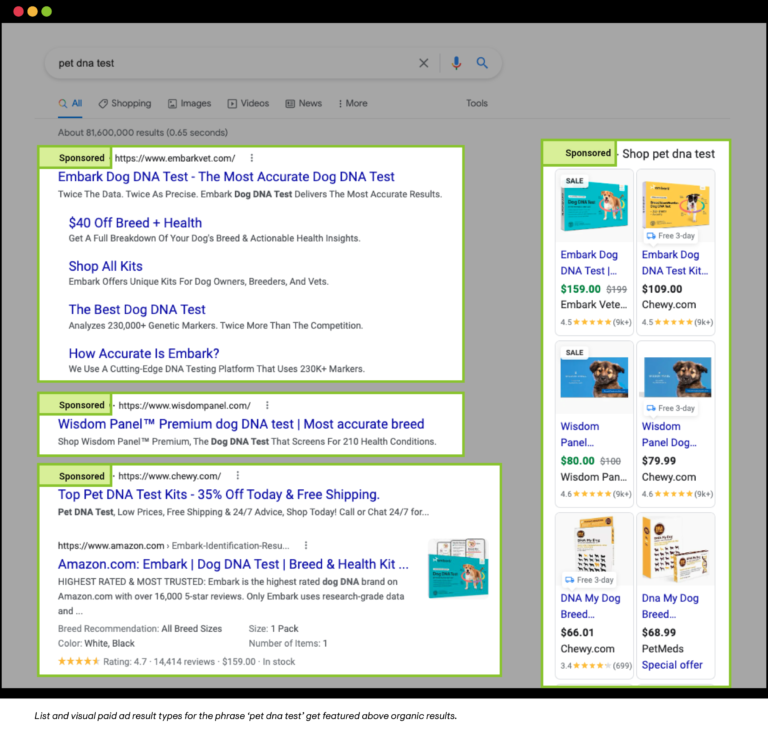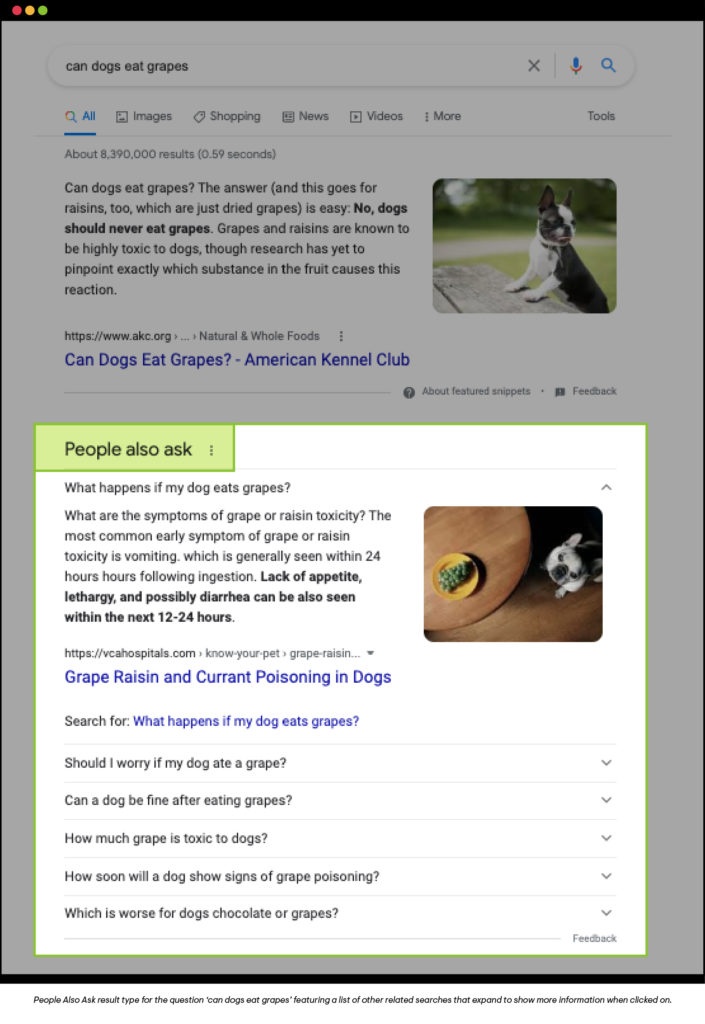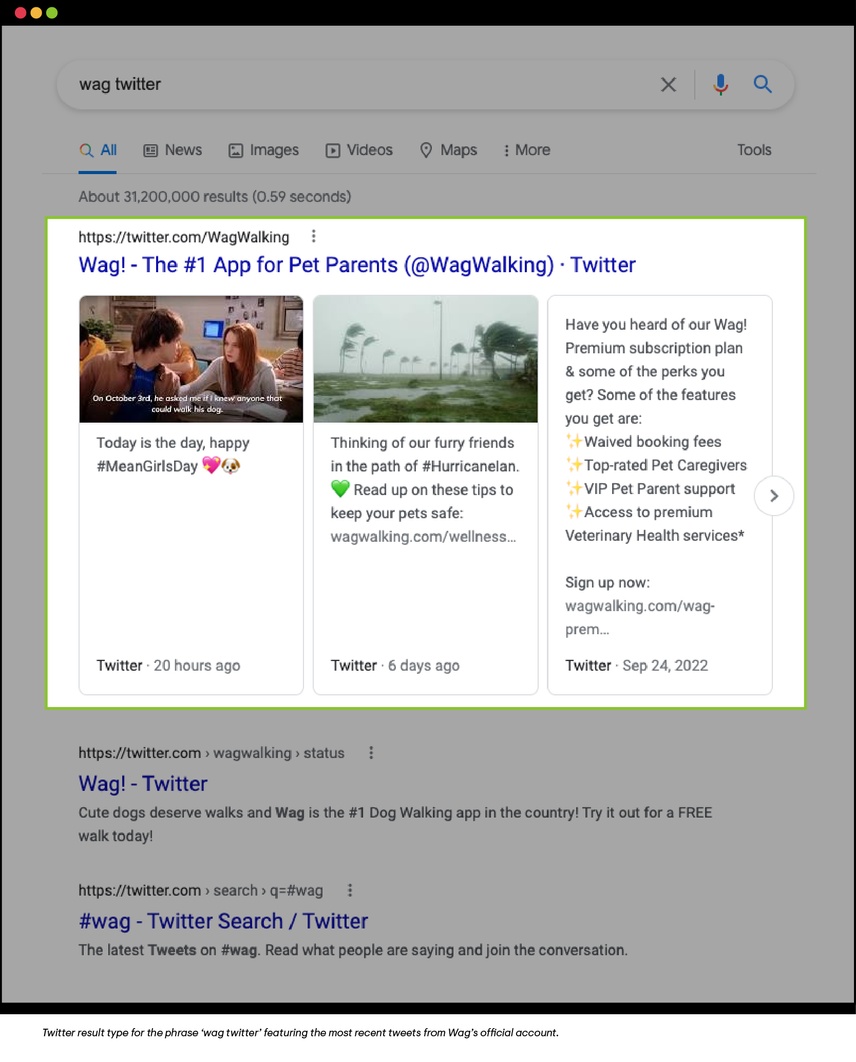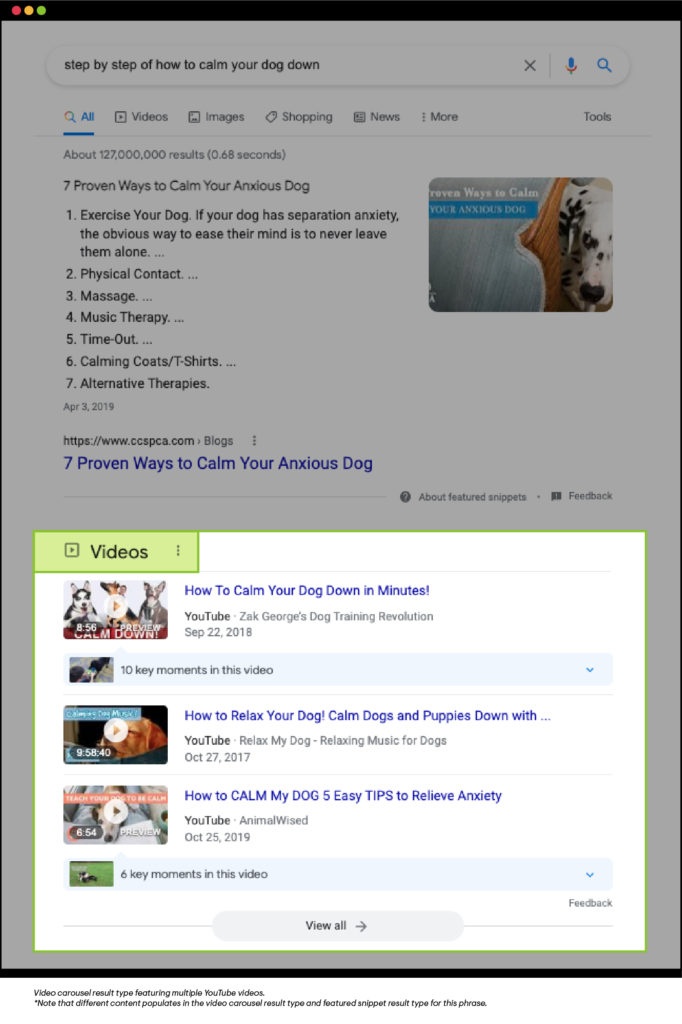The Top 5 SERP Features & How to Rank for Them with SEO
23.6% of U.S. e-commerce purchases start with an organic search on the internet, which is why learning how to increase your brand’s visibility in search results is critical.
With Google constantly updating its search algorithm and how it ranks content, it can be difficult to keep up and ensure your content marketingContent Marketing
Content marketing is a marketing discipline with the goal of increasing awareness and scope for products and brands in the desired target group with content published on the web and offline.
Learn more strategy remains aligned with the latest best practices.
Ten years ago, Google would return simple search results based on how well a pagePage
See Websites
Learn more is optimized with search engine optimization (SEO). Today, its focus is on making the user experienceUser Experience
User experience (or UX for short) is a term used to describe the experience a user has with a product.
Learn more as seamless as possible, so users can find the right information they are looking for as quickly as possible. Now, for almost any Google search, users will see a results page filled with different features like video carousels, images, and even related questions that other users ask.
These search engineSearch Engine
A search engine is a website through which users can search internet content.
Learn more results page (SERP) features typically appear at the top of the results page that follows any search. Because 90% of internet users click on links on the first page of the results , these SERP features take up prime real estate, making them critical to target and leverage through SEO and content marketing. Furthermore, according to a study by Sistrix, the top three results receive more than half of all clicks , with the first result earning the bulk of them (28.5%).
By understanding how these features work, determining which are most important, and learning how to benefit from them, your business can increase visibility in SERP, reach more customers, and drive more intent-driven visits to your site.
What are Google result types or SERP features?
At the highest level, SERP features can be split into two categories: organic results and paid results.
Paid results (ads) sit at the very top of the results page so that paying businesses get the highest possible returns from their advertising spend on search engines. Google recently rolled out an updated search ad label on Oct. 14. The update replaced the former black "Ad" label with the new black "Sponsored" label.

Unlike paid, organic results rely on quality content and SEO techniques to earn a spot on the SERP. These results aren’t paid for. Instead, they are ranked by Google based on the value and information they provide related to the user’s given keywordKeyword
A keyword is what users write into a search engine when they want to find something specific.
Learn more or search phrase.
Google is constantly testing new SERP features as they try to improve the customer experience. For instance, Google officially confirmed that they are testing a new SERP type called Perspectives. Although it isn’t live yet, users might see it very soon.
In the meantime, there are many different SERP features in rotation to consider ranking for, including:
- Answer Box/Featured Snippet: After searching a question, you might see a longer snippet of text from a top result that offers enough information, so you don’t even have to click on the link.
- Breadcrumb: Above a clickable link, a breadcrumb will showcase the trail that a specific page is nested under.
- Calculator: Math-related searches often result in a calculator option, giving you the chance to edit your equation directly in the SERP.
- Carousel Results: If you search for a listicle or use a search phrase like “best comedy movies 2022,” a carousel will populate with relevant, top-rated movies.
- Event Schedule: If a specific event has multiple times and dates, the event schedule can provide insight into available options.
- Events: If you’re looking for a concert near you, for instance, you might see the events SERP populate different shows, along with dates, venues, and even ticket prices.
- Flights: Comparing flights, prices, and airlines is made easy with the standout flights feature. Google has its own product for flight searches—known as Google Flights—which you can use to track prices based on specific flights, routes, and dates.
- Hotel Pack: Similar to flights, the hotel pack returns results for hotels in the area you’re searching, as well as price and availability.
- Images: Images can appear at the top of the results page when Google determines they offer helpful context or may be the target of the search.
- Jobs: Job hunting is largely done online nowadays, so popular job boards can have job listings populate on the first page of a related search.
- Knowledge Card: Great for dynamic searches, the knowledge card will provide visuals and details at a glance, like stock information.
- Knowledge Graph: Wikipedia-like, a knowledge graph provides brief information about a person, entity, or other search topic.
- Map: The map feature will display where a place or business is and even go as far as identifying how far it is from you if your location features are enabled.
- People Also Ask: These questions provide different ways to think about what you’re asking or helpful follow-up ideas.
- Plan a Trip: Different travel guides and recommendations of a certain area will populate when it’s relevant to your search.
- Podcasts: This carousel showcases podcast titles, dates, and lengths.
- Popular Products: When a user searches for a product, such as a hairbrush, the popular products feature will offer specific products in high demand.
- Recipes: Searching for a recipe will return links to recipes in the form of a carousel with images, providing a quick path to get the detailed information you need.
- Refine By: To narrow down your search, you can interact with the options offered by the “refine by” feature.
- Reviews: Populate underneath websiteWebsite
A website is a collection of HTML documents that can be called up as individual webpages via one URL on the web with a client such as a browser.
Learn more URLs to draw users’ attention and increase trust. - See Results About: When Google isn’t sure what you’re looking for, this is a main feature that will help direct your query correctly.
- Shopping Results: These results will display specific products, their prices, and where to buy them, reducing the number of clicks needed to make a purchase.
- Sitelinks: Additional website links populate below the main URLURL
The term URL is an acronym for the designation "Uniform Resource Locator".
Learn more to offer users related pages to explore. - Sports: Searching for a sport, team, or player will return special results of schedules, scores, draft picks, news, rosters, and player profiles, all without having to click on a website.
- Twitter: Seeing related tweets can help you find information on Twitter or access more details surrounding a specific person or company that tweets often.
- Video: Similar to images, videos, or video carousels can make it easy to find recordings of large events, viral moments, and more.
The list of available SERP features is growing and changing as Google tests new features, rolls them out for the long-term, or even eliminates them from rotation. SERP features are often personalized, so even if you search the same exact thing as another person, your results page might look different from theirs.
Why are Google result types important to SEO?
SERP features can take up 50% or more of the first page of results, making them a major traffic-driving component of search results that can’t be ignored if you want to increase quality clicks to your website.
Since Google’s indexIndex
An index is another name for the database used by a search engine. Indexes contain the information on all the websites that Google (or any other search engine) was able to find. If a website is not in a search engine’s index, users will not be able to find it.
Learn more contains hundreds of billions of web pages , it has an automated ranking system that publishes highly ranked content above other web pagesWeb Pages
When you enter an internet address (a URL, e.g. https://login.1und1.de/) into a web browser, a webpage will appear.
Learn more. Securing the top spot can lead to a 34.2% click-through rate , so investing in SEO and learning how to rank for SERP features can provide a massive boost to your business.
What are the top 5 features on the Google SERP?
As you can imagine, not all SERP features are created equally. Some are more popular, offer a better user experience, or present more information than others.
If you want to narrow down your focus to capitalize on some of the most important features, the following features below should be at the top of your list.
1. Answer Box (AKA Featured Snippet)
Often referred to as “Position #0” because it sits above all other results on the page, the Answer Box (or Featured Snippet) returns a “snippet” of text, and sometimes a relevant image, that provides information related to a user’s search.

What is the purpose?
An Answer Box provides a small block of text at the top of the results page, giving you a look at a few details before you even make a click. It makes finding detailed information as easy as possible. Not only can you see a snapshot of the information you will get if you do click that link, but sometimes, you can see all the information you need—without having to click at all. These types of “zero click” searches are becoming more common. For desktop users, zero-click rates sit at roughly 46.4% . And for mobile users, that number shoots up to 77.2%.
What is its value?
When people are searching for instructions, definitions, a list, or other detailed information—the faster they get it, the better. Sometimes they’re in a pinch or trying to come up with an answer quickly, and the Answer Box solves their question within a matter of seconds.
It’s not uncommon to click into a web page and scroll through the entire thing, only to find out it didn’t have what you needed. Answer Boxes circumvent those frustrating experiences and provide quality information quickly.
What are the SEO implications of Answer Boxes?
Without an Answer Box present, the first search engine result usually enjoys a 26% click-through rate (CTR). However, when an Answer Box is at the top of a page, it garners an 8.6% CTR , leaving the first organic result to drop to a 19.6% CTR . These numbers illustrate the value Answer Boxes provide to web pages and users.
2. People Also Ask
When you input a question to Google, one of the most common results will be a “People Also Ask” box. This SERP feature provides related questions that might be of interest.

What is the purpose?
When a person looks for information, it’s likely that they’ll want to dive deeper than their initial search. With the People Also Ask (PAA) feature, users can deep dive right from the results page, finding a wealth of related questions and information in a matter of seconds. It can also help narrow down a broader search, helping users find the specific details they’re looking for.
What is its value?
People Also Ask eliminates the need to enter additional search queries. It gives you a break from brainstorming related questions and searching them all one-by-one. This is a prime example of technology-focused optimization. It’s also a dynamic feature, so when you click into one of the dropdowns, the questions below it will change, becoming more tailored with each click.
What are the SEO implications of People Also Ask?
This feature has been around since 2015 and has quickly grown in popularity. It often appears within the top three results on the first SERP.So, if your webpage is featured in a PAA box, you’ll likely build a reputation as a subject matter expert. PAA results show up in 85% of queries , maintaining its dominance as a feature, so it’s not going anywhere anytime soon.
3. Carousel
Combining lists with images and other widgets, Carousel features are presented in many different contexts. Searching for actors in a movie might return a Carousel of all actors from the same movie. Or you might see a recipe Carousel when you search for chicken noodle soup recipes.

What is the purpose?
Carousels serve as another refinement tool for users. You might be looking for an office chair but have no idea what type you need. A product Carousel can populate different brands, prices, and styles to help you figure out what’s right for you.
What is its value?
With the integration of photos and details like prices, the Carousel can offer immense value. While reading words can be helpful, the supporting imagery is incredibly useful when people are looking for products, people, places, or food.
What are the SEO implications of a Carousel?
Because of their versatility, Carousels are shown often in search results. This SERP feature is valuable for e-commerce sites as products can be listed in a Carousel with prices and a link to buy them.
Getting listed in this type of feature can directly contribute to conversions and sales. The strength here largely lies in the versatility of this feature. You might even find a news article carousel if you search for current events.
4. Twitter
We all know Twitter as a prominent social media platform. But in 2015, Google and Twitter formed a strategic partnership. Now, this major SERP feature shows tweets from people and businesses related to the search query right at the top of the page. Usually, this feature will return recent tweets so users can see what’s being said in real-time.

What is the purpose?
Twitter has become a great tool for people to interact with brands and people they love. Twitter users ask questions and even navigate issues with a product or service.
With the Twitter SERP feature, users can find updates quickly. They can easily interact with a notoriously fast communication channel.
What is its value?
Many people look to Twitter for news, event updates, and entertainment. Every day, the social media platform is a source of breaking news, insider thoughts, and information that can’t be found anywhere else.
However, searching through Twitter itself requires an extra step. The integration as a SERP feature into Google makes it easier for users to find what they need without going to multiple sites.
What are the SEO implications of Twitter?
The Twitter box shows an entity’s most recent tweets if someone searches their name or Twitter handle. This can help signify to customers that your organization has an active online presence, which is more important than ever. Nearly 76% of consumers will look at the online presence of a business before visiting their organization in person or making a purchase.
5. Videos/Video Carousel
Studies have shown that people retain 95% of the information when they watch a video, as opposed to only 10% when they read information. The prevalence of video content is running rampant in all corners of the internet, and Google’s search results are no different.

What is the purpose?
Making video content easier to access is a challenge that search engines have been tackling in recent years. Not long ago, you had to go to YouTube or a video platform directly to search for video content. But since Google acquired YouTube in 2006, the engine integrates video results better than most search engines.
What is its value?
We live in a video-centric world now. People want to watch tutorials, see concerts they missed, and even quickly find clips of their favorite TV shows. With direct video results at the top of the SERP, users can avoid going to YouTube and quickly find what they’re looking for on Google.
What are the SEO implications of Videos?
The click-through rate for video-rich search results is a whopping 62% . If you can rank your website or video content on the first page of results, you’ll improve your online presence and reputation for offering quality video content. Traffic to your website might even pick up.
How can you optimize your web pages to rank for more result types?
Getting your content listed on the first page of Google is challenging enough. But with a plethora of SERP features that all have different requirements and ranking styles, it can be tough to know where to start.
However, with a few tried and true methods, you can start working your way up the rankingsRankings
Rankings in SEO refers to a website’s position in the search engine results page.
Learn more, appearing in more search results, and reaching larger audiences.
Prioritize new content built on SEO
With keywords and other SEO basics in mind, consistently publish new content and keep your website active. If you continue providing blog posts, articles, and videos with valuable information, traffic to your website will grow.
You can also go back into content that’s already been published and optimize it for search to boost any rankings it has. Editing blog posts for better readability, adding trendy keywords or phrases, and updating outdated information or links are great ways to add more value.
To set your content creation process up for success, follow these five key steps:
- Leverage search data to understand your audience and inform your brand voice
- Map keywords and topics to your personas and customer journey stages
- Optimize your content creation process
- Maximize your reach with a consistent content calendar
- Track metrics that matter to measure the performance of your content
Research efforts that help capture result types
The most important thing to do when trying to get Google to rank your content is to provide value. The longer people stay on your website and the more they explore different areas of your site, the better experience they’ll have.
Keep in mind that content shouldn’t be created for the sole purpose of ranking well in search. Per Google’s recent Helpful Content Update, the main focus should always be to create people-first content that provides value for the reader. Some will argue that keyword stuffing can be effective, but it is actually counter-productive and will hinder your ability to rank. When it comes to word count, the main thing Google will look for is too low of text to HTML ratio, which is something to keep in mind when creating campaign-specific landing pages. Word count should primarily be determined by providing the right amount of information to adequately support the reader and answer their questions. To capture special result types, you need to create high-quality content that puts the user first, solving their needs and answering their questions.
Each SERP will have different ranking factors. But by practicing good SEO and leveraging proven technical SEO tactics, you can increase your chances of capturing a top search resultSearch Result
Search results refer to the list created by search engines in response to a query.
Learn more. Conduct keyword research to give yourself direction on how to optimize your website to rank higher and become more visible to searchers. Identify customer needs and create content with a solution to their desire or problem.
Once you’ve optimized your website with proven SEO tactics (or at the very least done the basics), investigate each SERP feature that you think applies to what you offer and learn how that specific feature ranks content. Adapt your approach to fit the requirements to increase your chances of ranking, both overall and for special result types.
Use Schema markup to get richer results
Schema markup is semantic code that can be added to the source code of your website to help search engines better understand the content.
Schema is important for SEO as it provides structured dataStructured Data
Structured data is the term used to describe schema markup on websites. With the help of this code, search engines can understand the content of URLs more easily, resulting in enhanced results in the search engine results page known as rich results. Typical examples of this are ratings, events and much more. The Searchmetrics glossary below contains everything you need to know about structured data.
Learn more about the information on a page. It helps search engines return richer results on SERPs, and it may even improve click-through rates to your site.
To rank for search features, use Schema markup to help Google recognize that content should be formatted in a special result type in the SERP.
The most common Schema markup types include:
- Article
- Breadcrumbs
- Event
- Local Business
- Offer
- Organization
- Person
- Product
- Recipe
- Video
Identify result type opportunities with Conductor’s SEO platform
Understanding the SERP landscape is crucial to SEO success. One of the best ways to get insights is with an Enterprise SEO Platform that shows you the entire landscape of universal results and the opportunities where you could rank for various result types.







